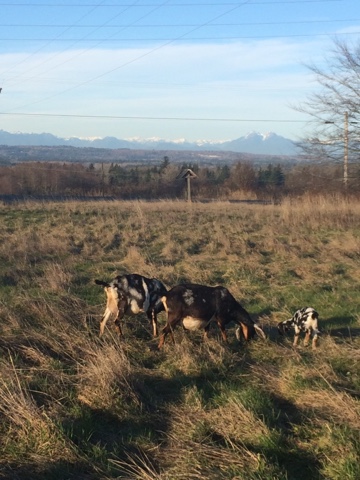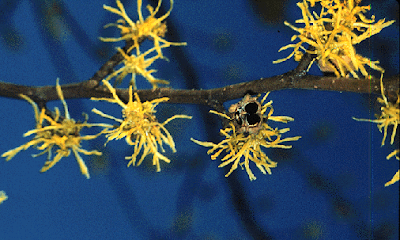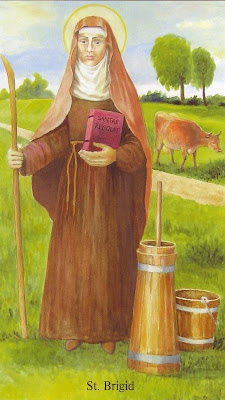I didn't go to Gleaner's Saturday, or at all last week. The cupboards were bare, so I dragged myself out there. I really don't know how I got through three hours of carrying boxes, sorting food, and making small talk. By the time I got home, about 12:30, I was ready to collapse.
Homero helped me put the food away and then went to check on Flopsy. He came back pretty quickly and said, "I think it's about time; she is in the barn, panting."
"Ok," I said, "just let me finish my coffee, and then let's go out together."
It was probably ten minutes later that we headed out to the barn. It was a beautiful sunny day - warm and bright. Nice day for baby goats to be born, I thought.
There were two babies on the ground when we got inside the barn. Flops was chuckling and licking them, but they were still all slimy and hadn't yet even tried to stand up. Clearly they had been born just a minute before. A beautiful little black and white spotty one, and a bigger, brown and white spotted one. I picked up the little things, getting slime all over my shirt, and brought them into the mama barn, which is warmer and drier. Homero came after me, leading Flopsy.
Homero hung around for a few minutes, and then went back to work. For the next 30 or 40 minutes, I watched the babies struggle to stand up and nurse. The smaller spotty one was a doeling, and the big brown one was a buckling. Considering how large Flopsy was, I was surprised that she had only had twins. But relieved, as well. With an udder damaged by a long-ago case of mastitis, Flopsy wouldn't be able to raise triplets. I had in fact made arrangements with a farmer friend to take an extra baby off our hands, should there be one. I don't care for bottle babies.
I was just starting to think that Flopsy was taking a long time to pass the afterbirth, when she commenced to paw at the straw and to push.I took a look at her rear end, and whoops! There was another bubble. There were three after all. I waited several more minutes, but Flopsy didn't seem to be making any progress, and it had, after all, been three-quarters of an hour since the twins were born. I decided I'd better see what was up.
After running back to the house for soap and hot water, I went exploring with my right hand. There was an unbroken bag of waters, but the baby was far away down in the uterus. Having just seen the vet, a few days ago, working elbow deep to turn Iris' baby, I knew that I could go in as deep as I needed to to figure out what was happening. But with that bulgy bag of waters in the way, I couldn't feel anything. And I didn't have a pocketknife on me. I never do - I seldom need one, but on the few occasions that I do, I always berate myself. It's a simple thing to do, carry a small pocketknife.
My fingernails are pretty long, though, and with a little work I was able to tear the bag open. After the waters spilled out, I could reach in far enough to feel the baby (Flopsy was being enormously cooperative - I didn't even have her on the stanchion). What I felt was a butt. I had a breech.
Baby goats can in fact come out hind end first - in fact, as long as the feet are extended, hind-end first is considered a normal presentation. All I had to do was find the feet and bring them forward. This time, it was very easy. I don't know if that's because Flopsy is a big, roomy doe, with an enormous uterus that had already expelled two babies, or if I was more relaxed about exploring as far as necessary, after seeing the kind of treatment a doe can take and still be just fine afterwards. In any case, it only took me about forty seconds to find the feet and bring them forwards, flexing the legs and knee and ankle.
Once the feet were in position, the baby was born very quickly. Another big buck. He was fairly exhausted, but Flopsy set to work licking him off and he lifted his head and snorted. I ran back to the house to wash my hands and grab another clean towel. I stopped b y the shop to tell Homero that there were three after all, and he came with me to see the third baby.
But I was wrong, There weren't three. A fourth baby was snorting and snuffling on the hay by the time we got back. Quads! We've never had quads on the farm before. The last baby, was another buckling, a handsome black boy with white ears.
I called my farmer friend and asked her if she wanted TWO bottle babies. She did, and she came right over with a bottle of colostrum from her freezer and her two adorable little boys. Sometime a little later in the spring, she's going to bring over her rototiller for us to use, in trade.
Now I'm ready for a well earned hot bath.














